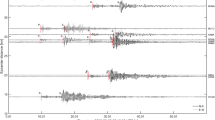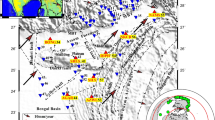Abstract
Shear-wave splitting measurements from local and teleseismic earthquakes are used to investigate the seismic anisotropy in the upper mantle beneath the Rwenzori region of the East African Rift system. At most stations, shear-wave splitting parameters obtained from individual earthquakes exhibit only minor variations with backazimuth. We therefore employ a joint inversion of SKS waveforms to derive hypothetical one-layer parameters. The corresponding fast polarizations are generally rift parallel and the average delay time is about 1 s. Shear phases from local events within the crust are characterized by an average delay time of 0.04 s. Delay times from local mantle earthquakes are in the range of 0.2 s. This observation suggests that the dominant source region for seismic anisotropy beneath the rift is located within the mantle. We use finite-frequency waveform modeling to test different models of anisotropy within the lithosphere/asthenosphere system of the rift. The results show that the rift-parallel fast polarizations are consistent with horizontal transverse isotropy (HTI anisotropy) caused by rift-parallel magmatic intrusions or lenses located within the lithospheric mantle—as it would be expected during the early stages of continental rifting. Furthermore, the short-scale spatial variations in the fast polarizations observed in the southern part of the study area can be explained by effects due to sedimentary basins of low isotropic velocity in combination with a shift in the orientation of anisotropic fabrics in the upper mantle. A uniform anisotropic layer in relation to large-scale asthenospheric mantle flow is less consistent with the observed splitting parameters.








Similar content being viewed by others
References
Backus GE (1962) Long-wave elastic anisotropy produced by horizontal layering. J Geophys Res 67:4427–4440
Bagley B, Nyblade AA (2013) Seismic anisotropy in eastern Africa, mantle flow, and the African superplume. Geophys Res Lett 40:1500–1501. doi:10.1002/grl.50315
Batte AG, Rümpker G, Lindenfeld M, Schumann A (2014) Structurally controlled seismic anisotropy above small earthquakes in crustal rocks beneath the Rwenzori region, Albertine Rift, Uganda. J Afr Earth Sci (submitted)
Ben Ismail W, Mainprice D (1998) An olivine fabric database: an overview of upper mantle fabrics and seismic anisotropy. Tectonophysics 296:145–158
Bendick R, McClusky S, Bilham R, Asfaw L, Klemperer S (2006) Distributed Nubia–Somalia relative motion and dike intrusion in the main Ethiopian rift. Geophys J Int 165:303–310
Bosworth W, Strecker MR, Bliniuk PM (1992) Integration of East African paleostress and present-day stress data: implications for continental stress field dynamics. J Geophys Res 97:11851–11865
Chorowicz J (2005) The East African Rift system. J Afr Earth Sci 43:379–410
Crampin S (1991) Wave propagation through fluid-filled inclusions of various shapes: interpretation of extensive-dilatancy anisotropy. Geophys J Int 104:611–623
Ebinger CJ (1989) Tectonic development and the western branch of the East African rift system. Geol Soc Am Bull 101:885–903
Foley SF (1992) Vein-plus-wall-rock melting mechanisms in the lithosphere and the origin of potassic alkaline magmas. Lithos 28:435–453
Foley SF, Link K, Tiberindwa JV, Barifaijo E (2012) Patterns and origin of igneous activity around the Tanzanian craton. J Afr Earth Sci 62:1–18
Fouch MJ, Rondenay S (2006) Continental seismic anisotropy. Phys Earth planet Int 158:292–320
Gao SS, Davis PM, Liu H, Slack PD, Rigor AW, Zorin YZ, Mordvinova VV, Kozhevnikov VM, Meyer RP (1994) Seismic anisotropy and mantle flow beneath the Baikal rift zone. Lett Nat 371:149–151
Gao SS, Davis PM, Liu H, Slack PD, Rigor AW, Zorin YZ, Mordvinova VV, Kozhevnikov VM, Logatchev NA (1997) SKS splitting beneath the continental rift zones. J Geophys Res 102:22781–22797
Gao SS, Liu KH, Abdelsalam MG (2010) Seismic anisotropy beneath the Afar depression and adjacent areas: implications for mantle flow. J Geophys Res 115. doi:10.1029/2009JB007141
Gummert M, Lindenfeld M, Wölbern I, Rümpker G, Kasereka CM, Batte AG (2014) Crustal structure and high-resolution Moho topography across the Rwenzori region (Albertine rift) from P-receiver functions. Submitted to Geological Society, London, Special Publications
Hammond JOS, Kendall JM, Angus D, Wookey J (2010) Interpreting spatial variations in anisotropy: insights into the main Ethiopian rift from SKS waveform modeling. Geophys J Int 181:1701–1712
Heintz M, Kennett BLN (2005) Continental scale shear-wave splitting analysis: investigation of seismic anisotropy underneath the Australian continent. Earth Planet Sci Lett 236:106–119
Holtzman BK, Kendall JM (2010) Organized melt, seismic anisotropy, and plate boundary lubrication. Geochem Geophys Geosyst 11:Q0AB06. doi:10.1029/2010GC003296
Ikelle LT, Amundsen L (2005) Introduction to petroleum seismology. Society of Exploration Geophysicists, Tulsa
Karato SI (2003) The dynamic structure of the deep Earth: an interdisciplinary approach. Princeton University Press, Princeton
Kendall JM (1994) Teleseismic arrivals at a mid-ocean ridge: effects of mantle melt and anisotropy. Geophys Res Lett 21:301–304
Kendall JM, Stuart GW, Ebinger CJ, Bastow ID, Keir D (2005) Magma assisted rifting in Ethiopia. Nature 433:146–148
Kumazawa M, Anderson OL (1969) Elastic moduli, pressure derivatives, and temperature derivatives of single-crystal olivine and single-crystal forsterite. J Geophys Res 74:5961–5972
Lindenfeld M, Rümpker G (2011) Detection of mantle earthquakes beneath the East African rift. Geophys J Int 186:1–5
Lindenfeld M, Rümpker G, Batte A, Schumann A (2012) Seismicity at the Rwenzori Mountains, East African rift: earthquake distribution, magnitudes and source mechanisms. Solid Earth 3:251–264
Link K, Koehn D, Barth MG, Tiberindwa JV, Barifaijo E, Aanyu K, Foley SF (2010) Continuous cratonic crust between the Congo and Tanzania blocks in western Uganda. Int J Earth Sci 99(7):1559–1573. doi:10.1007/s00531-010-0548-8 (Special Issue “Long-term Rift Evolution”)
Long MD, Silver PG (2009) Shear wave splitting and mantle anisotropy: measurements, interpretations, and new directions. Surv Geophys 30:407–461
Nicolas A, Christensen NI (1987) Formation of anisotropy in upper mantle peridotites: a review, in composition, structure, and dynamics of the lithosphere–asthenosphere system. Geodyn Ser 16, Fuchs K and Froidevaux C (ed), AGU, Washington, DC, pp 111–123
Nicolas A, Achauer U, Daignieres M (1994) Rift initiation by lithospheric rupture. Earth Planet Sci Lett 123:281–298
Nyblade AA, Brazier RA (2002) Precambrian lithosphere controls on the development of the East African rift system. Geology 30:755–758
Rosenthal A, Foley SF, Pearson DG, Nowell GM, Tappe S (2009) Petrogenesis of strongly alkaline primitive volcanic rocks at the propagating tip of the western branch of the East African rift. Earth Planet Sci Lett 284:236–248
Rümpker G, Ryberg T (2000) New “Fresnel-zone” estimates for shear-wave splitting observations from finite-difference modeling. Geophys Res Lett 27:2005–2008
Rümpker G, Silver PG (1998) Apparent shear-wave splitting parameters in the presence of vertically varying anisotropy. Geophys J Int 135:790–800
Ryberg T, Rümpker G, Tittgemeyer M, Wenzel F (2002) Finite-difference simulations of seismic wavefields in isotropic and anisotropic Earth models. In: Krause E, Jäger W (eds) High performance computing in science and engineering 2001. Springer, Berlin, pp 35–47
Sander S, Rosendhal BR (1989) The geometry of rifting in Lake Tanganyika, East Africa. J Afr Earth Sci 8:323–354
Savage MK (1999) Seismic anisotropy and mantle deformation: what have we learned from shear wave splitting? Rev Geophys 37:65–106
Silver PG (1996) Seismic anisotropy beneath the continents: probing the depths of geology. Annu Rev Earth Planet Sci 24:385–432
Silver PG, Chan WW (1991) Shear-wave splitting and subcontinental mantle deformation. J Geophys Res 96:16429–16454
Stamps DS, Calais E, Saria E, Hartnady CH, Nocquet JM, Ebinger CJ, Fernandes RM (2008) A kinematic model for the East African rift. Geophys Res Lett 35:L05304. doi:10.1029/2007GL032781
Tommasi A (1998) Forward modeling of the development of seismic anisotropy in the upper mantle. Earth Planet Sci Lett 160:1–13
Vauchez A, Tommasi A, Barroul G, Mamus J (2000) Upper mantle deformation and seismic anisotropy in continental rifts. Phys Chem Earth A 25(2):111–117
Walker KT, Nyblade AA, Klemperer SL, Bokelmann GHR, Owens TJ (2004) On the relationship between extension and anisotropy: constraints from shear-wave splitting across the East African Plateau. J Geophys Res 109. doi:10.1029/2003JB002866
Wallner H, Schmeling H (2010) Rift induced delamination of mantle lithosphere and crustal uplift: a new mechanism for explaining Rwenzori Mountains extreme elevation? Int J Earth Sci doi:10.1007/s00531-010-0521-6
Wölbern I, Rümpker G, Link K, Sodoudi F (2012) Melt infiltration of the lower lithosphere beneath the Tanzania craton and the Albertine rift inferred from S receiver functions. Geochem Geophys Geosyst 13(1). doi:10.1029/2012GC004167
Wölbern I, Löbl U, Rümpker G (2014) Crustal origin of trench-parallel shear-wave fast polarizations in the Central Andes. Earth Planet Sci Lett 392:230–238. doi:10.1016/j.epsl.2014.02.032
Wolfe CJ, Silver PG (1998) Seismic anisotropy of oceanic upper mantle: shear-wave splitting methodologies and observations. J Geophys Res 103:749–771
Zhang S, Karato SI (1995) Lattice preferred orientation of olivine aggregates deformed in simple shear. Nature 375:774–777. doi:10.1038/375774a0
Acknowledgments
Funding for this study was provided by the Deutsche Forschungsgemeinschaft (DFG). We thank the Geophysical Instrumentation Pool Potsdam (GIPP) for providing the seismological equipment and GEOFON for archiving the data. The support of the Ugandan National Council for Science and Technology and of the Ugandan Wildlife Authority is greatly appreciated. Data from station MBAR has been provided by GSN-IRIS/IDA. The manuscript significantly benefited from the constructive comments and suggestions of Tuna Eken and one anonymous reviewer.
Author information
Authors and Affiliations
Corresponding author
Electronic supplementary material
Below is the link to the electronic supplementary material.
Appendix
Appendix
The numerical simulations of seismic wave fields presented in this paper are based on the heterogeneous wave equation
where i, j, k, l = 1, …, 3, ρ denotes the density, u i is the displacement and C ijkl is the elastic tensor. Changes in material properties are restricted to the vertical \(x_{1} ,x_{3}\) coordinate plane in a reduced 2-D Cartesian geometry. This implies that any spatial derivative \(\delta_{{x_{2} }}\) vanishes. To discretize the wave equation on a grid, the finite-difference method is used up to the second-order approximation. The procedure is identical to Ryberg et al. (2002). An equidistant grid spacing of ∆x = ∆z = 0.25 km is assumed. A sampling rate of ∆t = 0.0175 s was found to be suitable to insure a robust discretization. For the comparison with SKS phases, a period of T = 8 s is used. As side effects are to be neglected, the grid size is chosen much larger than the evaluated model area.
In this work, anisotropy due to shape-preferred orientation of isotropic material is assumed. The elastic tensor of the effective anisotropic medium can be described by five independent elastic constants. The matrix of elastic constants for a horizontally transverse isotropic medium (HTI) is given by Ikelle and Amundsen (2005)
The effective elastic constants of the HTI-medium are derived by an analytical solution (Ikelle and Amundsen 2005).
Rights and permissions
About this article
Cite this article
Homuth, B., Löbl, U., Batte, A.G. et al. Seismic anisotropy of the lithosphere/asthenosphere system beneath the Rwenzori region of the Albertine Rift. Int J Earth Sci (Geol Rundsch) 105, 1681–1692 (2016). https://doi.org/10.1007/s00531-014-1047-0
Received:
Accepted:
Published:
Issue Date:
DOI: https://doi.org/10.1007/s00531-014-1047-0




